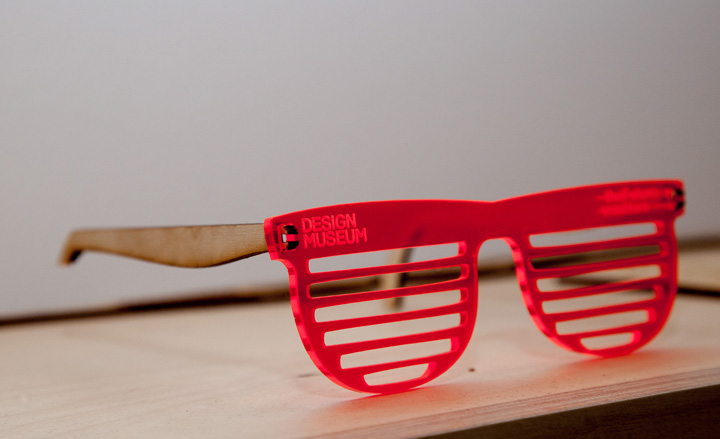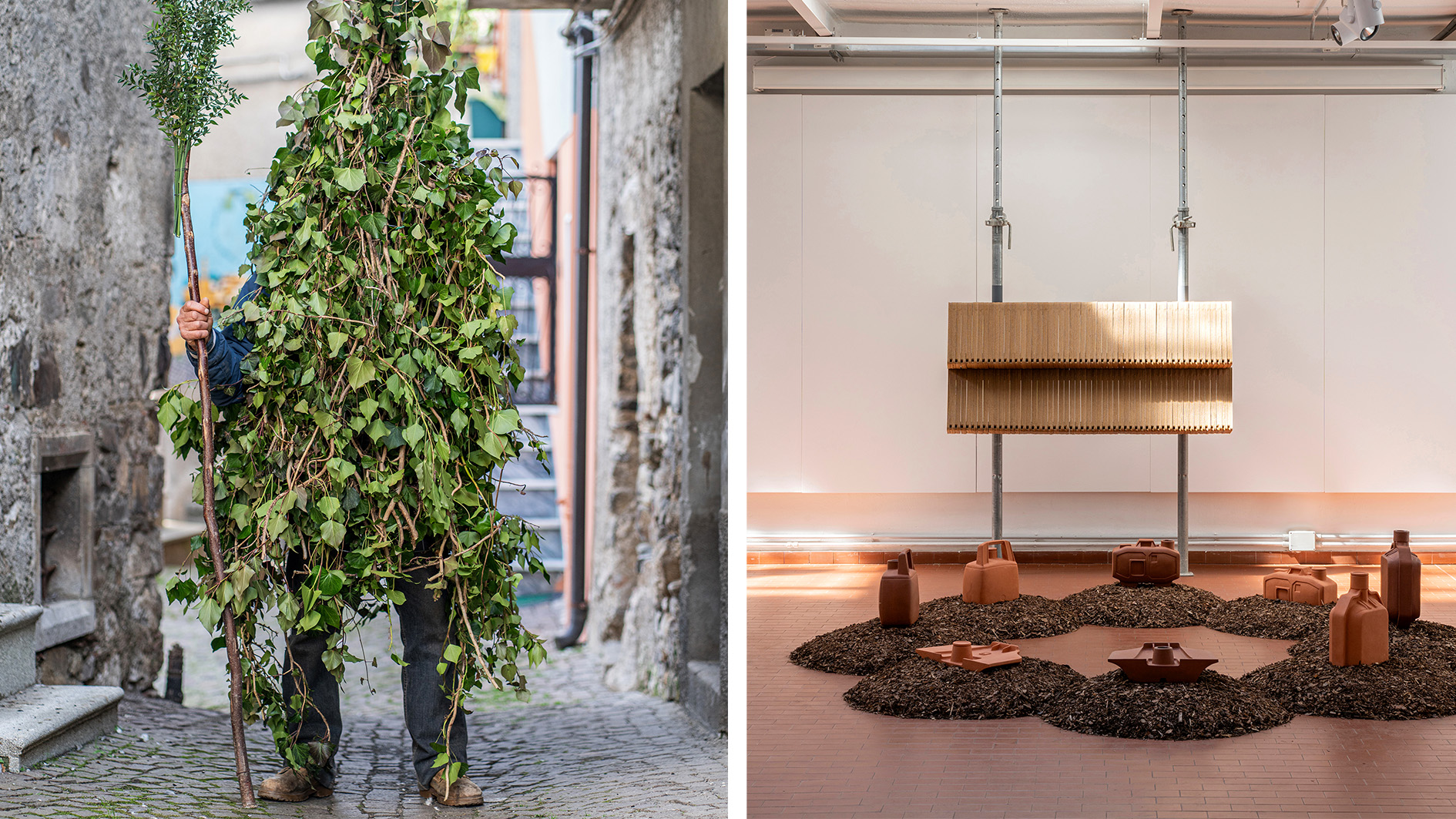'The Future is Here' exhibition at the Design Museum, London

Will technology save manufacturing? The subtitle of the Design Museum's major new show, The Future is Here, implies a positive response. We are on the edge of a 'new industrial revolution,' it proclaims, offering up the methods and means that will take us into a post-industrial age.
The relationship between the crunchy old analogue world of manufacturing and the seamless visions of the digital realms has become pretty blurred, as more and more ways emerge to translate the virtual into the physical realm. This new show suggests that a coming age of tech-driven, low volume manufacturing can kickstart a revolution in making and buying, one in which 'the boundaries between designer, maker and consumer are disappearing.'
Curator Alex Newson has done an excellent job of compiling a snapshot of a particular moment in time. The work on display is beautiful, subdivided into various zeitgeisty categories like digital fabrication, sustainability, closed loop design, crowdsourcing; a vogueishly cardboard installation, by dRMM is tough, tactile and utterly suited to the content. The graphics too are deft, functional and elegant, thanks to the involvement of LucienneRoberts+.
A key part of the exhibition is the 'Future is Here Factory,' a collection of 3D printers set up to allow visiting designers to produce ultra-short runs of objects, which in turn will be available to exhibition visitors to assemble and buy. It seems you can't visit a contemporary design show anywhere in the world without hearing the adenoidal whine of a 3D printer, slowly churning out some small chalky piece of dubious product design - here's hoping the DM's audience will make a difference. However, these are still machines for the workshop, not the kitchen work surface (although British high street electronics company Maplin recently ventured into home 3D printing.
'The Future Is Here' carries with it an oxymoronic undercurrent of wistful nostalgia, a longing for a tomorrow that is perpetually just out of reach, forever promising a transformation but never quite achieving it. Yes, the products are great. Yes, the technology is changing fast. But the thing that brings both together has yet to materialise. The first wave of 3D printing, routing and crowd-sourced thinking represents an advance party of pure creativity, but is it destined to sink below a deluge of mediocrity once the technology hits the mainstream?
The core belief in the power of technology to solve any problem at a stroke is also slightly jarring. High-end industry - the robots of KUKA, Tesla's factory, Lexus' carbon fibre weaving, Puma's biodegradable shoes - sits alongside ersatz, small-scale projects. The Makie Doll, a bespoke 3D printed toy (a kind of Build-a-Bear for grown-ups, list price £70) stands in stark contrast to the Rolls-Royce Trent 1000 aero engine (list price $17m). It's hard to draw parallels beyond the fact that both use intensive, computer-aided manufacture.
The shift in focus from raw materials to the methods used to translate them into 'designed' objects leaves many other questions unanswered. Someone will still have to manufacture the vast quantities of plywood required for this brave new flat pack future - a material that requires immense heat, pressure and, usually, highly toxic formaldehyde-based glues, not to mention vast factories, infrastructure and energy.
What is important is prototyping and design development, and technology compresses timescales and eases production like never before. Will it, as the exhibition implies, transform Britain's fortunes to a new golden age of manufacture? In this particular case, the magic bullet of technology is a blast of free-market freethinking that could ultimately disenfranchise designers rather than empower them.
Receive our daily digest of inspiration, escapism and design stories from around the world direct to your inbox.
We've been here before. What is Wallpaper*'s groundbreaking Handmade exhibition if it isn't an exploration of how design, craft and technology are changing the shape of how we define manufacturing, customisation and the bespoke object? Innovation and technology have a purpose - they are a means to an end. But just because you can bring anything to market doesn’t mean you should: curation and creation are two arts that are frequently confused.
'The Future is Here' throws up many fascinating case studies and many beautiful objects. But ultimately it doesn't offer a realistic economic foundation for this new age of self-contained manufacturing beyond the sound bite statement that innovation will always prevail.

Curator Alex Newson has done an excellent job of compiling a snapshot of a particular moment in time. The work on display is beautiful, subdivided into various zeitgeisty categories like digital fabrication, sustainability, closed loop design and crowd-sourcing

The exhibition suggests that a coming age of tech-driven, low volume manufacturing can kickstart a revolution in making and buying, one in which 'the boundaries between designer, maker and consumer are disappearing

MakerBot: The handloom of the 21st century. The relationship between the crunchy old analogue world of manufacturing and the seamless visions of the digital realms has become pretty blurred, as more and more ways emerge to translate the virtual into the physical realm

These laser-cut specs were made by a member of the public in the exhibition's Pop-Up Factory, which allows the public to get hands on with 3D printer and demos

3D printer by FormLabs

3D printed dolls by MakieLab

Installation view of 'The Future is Here' at the Design Museum
ADDRESS
Design Museum London
28 Shad Thames
London SE1 2YD
Jonathan Bell has written for Wallpaper* magazine since 1999, covering everything from architecture and transport design to books, tech and graphic design. He is now the magazine’s Transport and Technology Editor. Jonathan has written and edited 15 books, including Concept Car Design, 21st Century House, and The New Modern House. He is also the host of Wallpaper’s first podcast.
-
 Let’s hear it for the Chopard L.U.C Grand Strike chiming watch
Let’s hear it for the Chopard L.U.C Grand Strike chiming watchThe Swiss watchmaker’s most complicated timepiece to date features an innovative approach to producing a crystal-clear sound
-
 Form... and flavour? The best design-led restaurant debuts of 2025
Form... and flavour? The best design-led restaurant debuts of 2025A Wallpaper* edit of the restaurant interiors that shaped how we ate, gathered and lingered this year
-
 The rising style stars of 2026: Zane Li, fashion’s new minimalist
The rising style stars of 2026: Zane Li, fashion’s new minimalistAs part of the January 2026 Next Generation issue of Wallpaper*, we meet fashion’s next generation. First up, Zane Li, whose New York-based label LII is marrying minimalism with architectural construction and a vivid use of colour
-
 Design beyond humans: a new exhibition argues that the world doesn’t revolve around us
Design beyond humans: a new exhibition argues that the world doesn’t revolve around us‘More Than Human’ at London's Design Museum (until 5 October 2025) asks what happens when design focuses on the perspectives and needs of other species, from bees to seaweed
-
 Design Museum exhibition puts waste front and centre
Design Museum exhibition puts waste front and centre‘Waste Age: What Can Design Do?’ at the Design Museum, London (until 20 February 2022), presents design’s proposals and solutions to the issue of waste
-
 Saul Steinberg: behind the scenes at Triennale Design Museum
Saul Steinberg: behind the scenes at Triennale Design MuseumTriennale Design Museum and publishing house Electa present ‘Saul Steinberg Milano New York’, a new exhibition (until 13 March 2022) that pays homage to the American artist through 350 works. Join us for a behind-the-scenes peek at it's installation
-
 Ten years of Muller Van Severen, at Design Museum Ghent
Ten years of Muller Van Severen, at Design Museum GhentA new exhibition by Belgian design duo Muller Van Severen (until 6 March 2022) features a retrospective of the studio’s ten years as well as a curation of pieces from the Design Museum Ghent collections
-
 Noguchi show celebrates his reverence for Greece
Noguchi show celebrates his reverence for GreeceDesign show ‘Objects of Common Interest: Hard, Soft, and All Lit Up with Nowhere to Go’ opens in collaboration with Wallpaper* Designers of the Year, Objects of Common Interest, at the Noguchi Museum in Queens, New York (until 13 February 2022)
-
 Discovered champions new talent at Design Museum
Discovered champions new talent at Design MuseumTwenty next-generation designers unveil works in sustainable wood as part of Discovered, a collaboration between AHEC and Wallpaper*, presented at the Design Museum, London
-
 ‘Design not for children, but for everyone’: Jewish Museum Berlin’s new play space
‘Design not for children, but for everyone’: Jewish Museum Berlin’s new play spaceOlson Kundig architecture and design practice brings kids’ play space ANOHA Children’s World to life inside a vast former wholesale flower market, at the Jewish Museum Berlin
-
 A landscape of playful animals pops up at Design Museum Holon
A landscape of playful animals pops up at Design Museum HolonChild-centric designer Sarit Shani Hay presents an imaginary natural landscape that references Ron Arad's Design Museum Holon architecture and is inhabited by soft, cushioned sea lions, seals and bears